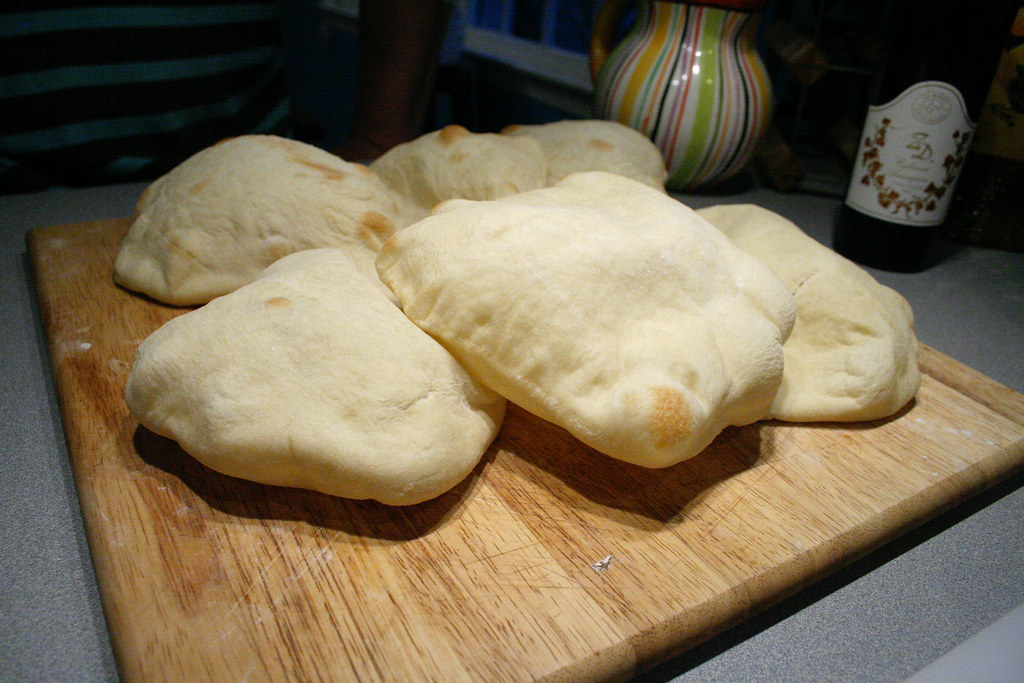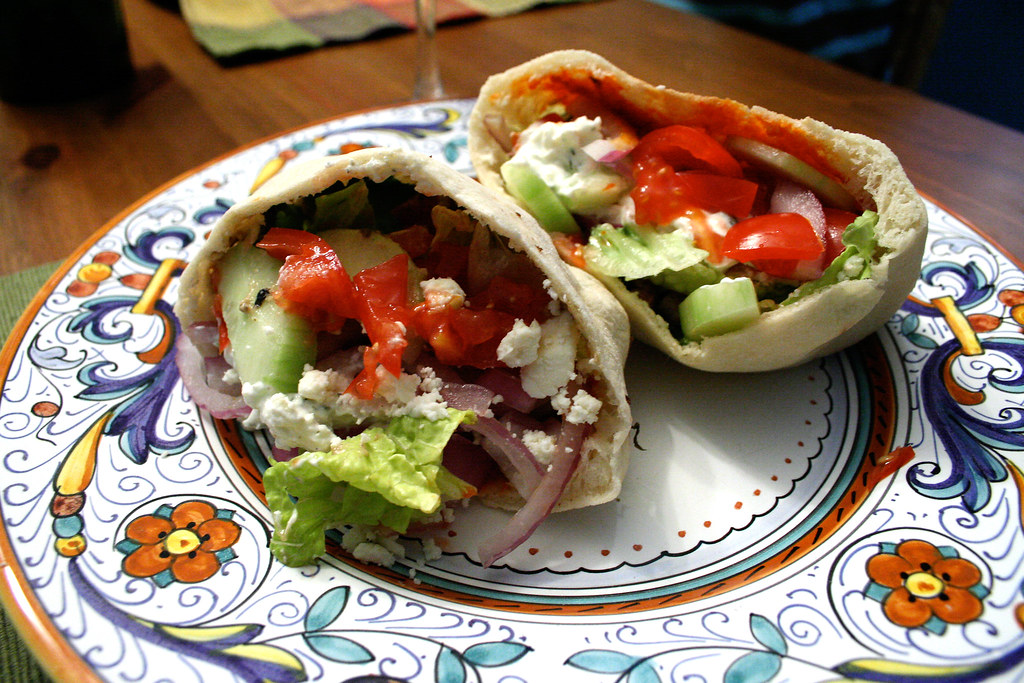Pita Party

I've tried making pita bread before, with less than perfect, puffy results. They certainly tasted great, better than any store-bought pita of recent consumption that I can recall. Yet they remained resolutely, obstinately, tooth-grindingly flat. A stray bubble may lazily have pushed its way up, but that was the extent of things. Recently in the mood for gyros, I decided it was time for round two, under the tutelage of baking perfectionist Rose Levy Beranbaum.
Since I was doing this fairly last moment, there would be no time for her recommended overnight flavor-intensification in the fridge. The dough came together easily with the assistance of my KitchenAid, and was deposited, bowl and all, inside the microwave for an hour-and-a-half long rise.
Now, Rose warns you that it is extremely important to have a hot oven, and recommends that you let it pre-heat for an hour. I let mine and my pizza stone go for about an hour and a half at 500-degrees, before turning it down to the recommended temperature. During that time, I busied myself with dicing all those scrummy little veggies that round out every perfect pita party. When the time arrived, I portioned the dough into small circles, then covered them with a tea-towel for an additional ten minutes of rising. Finally, the inflated blobs of dough were rolled out, then quickly tossed two at a time into a face-searingly hot oven.
And.. drum roll, folks...
 Success! At long last, baby, the perfect puff is mine! Not so much the perfectly round pita, but that's fine. As in yoga, so it goes in baking: it's always good to have something to work towards.
Success! At long last, baby, the perfect puff is mine! Not so much the perfectly round pita, but that's fine. As in yoga, so it goes in baking: it's always good to have something to work towards.Palates tantalized, my crew and I gathered around the kitchen counter, dishing out some slow-cooked lamb and beef, adding finely shredded lettuce, summer-ripe tomatoes, kalamata olives and red onions. With a little help from Trader Joe's tzatziki sauce and red pepper spread, the gyros were done. And yes, they did indeed rock the Kasbah.
Remarks on this recipe:
First of all, Rose didn't specify what type of salt to use; I used regular ol' table salt. The salt flavor in the finished product was pronounced, but in a good way-- it really made the bread. I also didn't bother transferring the freshly-mixed dough into a different bowl. I sprayed olive oil under, around, and on the dough, covered the bowl with a kitchen towel, and tucked it into a closed microwave oven for rising. The freshly cooked pitas were not only placed on towels, but covered by one as well, so as not to dry out.
Of pitas and puffiness:
The water in the dough turns to steam in the heat of the oven, and that transformation is what causes the dough to inflate into that familiar pita shape. With that in mind, the two most important things in obtaining the perfect puff. Number one: If you throw your first couple of pitas in the oven and don't see a lot of puffing, work some water into the remaining rounds of dough; re-roll, and briefly let rise again. Number two: Don't forget to get that oven hot-hot-hot! Let it heat up for longer than you think you should, then let it go just a bit further. And don't forget, it may take a try or two before getting the feel of the proper pita. No matter the level of puff, these are inevitably far superior to dry, dull supermarket fare.

Some thoughts on what to fill them with:
If you've eaten gyros at a restaurant, then you know the deal. The meat is typically some mixture of tender chicken/beef/lamb: leftovers work excellent in this regard. Accompaniments include (but aren't limited to)onions, tomatoes, olives, cucumbers and the garlicky goodness of tzatziki.
Pita Bread
from Rose Levy Beranbaum's The Bread Bible
[Ingredients are listed as volume/ounces/grams]
-unbleached all-purpose flour (use only Gold Medal, King Arthur, or Pillsbury) 3 cups, plus a scant 1/4 cup / 16 ounces/ 454 grams
-salt 2 teaspoons/ 0.5 ounce/ 13.2 grams
-instant yeast 2 teaspoons/ --/ 6.4 grams
-olive oil 2 tablespoons/ 1 ounce/ 27 grams
-water, at room temperature 1 1/4 liquid cups/ 10.4 ounces/ 295 grams
Begin mixing the dough about 1 1/2 hours before shaping, or for best flavor development, 8 hours to 3 days ahead.
Mixer Method: In the bowl of stand mixer, combine all ingredients. With the paddle attachment, mix on low speed (#2 on a KitchenAid), just until all the flour is moistened, about 20 seconds. Change to the dough hook, raise the speed to medium (#4 on a KitchenAid), and knead for 10 minutes. The dough should clean the bowl and be very soft and smooth and just a little sticky to the touch. Add a little flour or water if necessary. (The dough will weigh 27.75 ounces/793 grams)
Let the dough rise. Using an oiled spatula or dough scraper, scrape the dough in to a 2-quart or larger dough-rising container or bowl, lightly greased with cooking spray or oil. Press the dough down and lightly spray or oil the top of it. Cover the container with a lid or plastic wrap. With a piece of tape, mark the side of the container at approximately where double the height of the dough would be. Refrigerate the dough overnight (or up to 3 days), checking every hour for the first 4 hours and pressing it down if it starts to rise.
Preheat the oven to 475-degrees 1 hour before baking. Have an oven shelf at the lowest level, and place a baking stone, cast-iron skillet, or baking sheet on it before pre-heating.
Shape the dough. Cut the dough into 8 or 12 pieces. Work with one piece at a time, keeping the rest covered with a damp cloth. On a lightly floured counter, with lightly floured hands, shape each piece into a ball and then flatten it into a disk. Cover the dough with oiled plastic and allow it to rest for 20 minutes at room temperature. Roll each disk into a circle a little under 1/4-inch thick. Allow them to rest, uncovered, 10 minutes before baking.
Bake the pita. Quickly place 1 piece of dough directly on the stone or in the skillet or on the baking sheet, and bake for 3 minutes. The pita should be completely puffed, but not beginning to brown. The dough will not puff well if it is not moist enough. See how the pita puffs, then, if necessary, spray and knead each remaining piece with water until the dough is soft and moist; allow to rest again and reroll as before. (However, those that are not puffed are still delicious to eat.) Proceed with the remaining dough, baking 3 or 4 pieces at a time if using a stone or baking sheet. Using a pancake turner, transfer the pita breads to a clean towel, to stay soft and warm. Allow the oven to reheat for 5 minutes between batches. The pitas can be reheated for about 30 seconds in a hot oven before serving.
Hey, wait!!! One more thing on innards...


0 Comments:
Post a Comment
<< Home